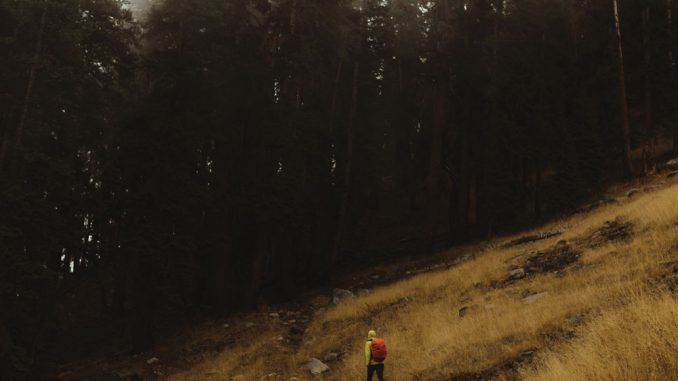
Humans are social animals. They naturally enjoy, and have a need for, constant social interaction. Sure, everyone looks forward to some quiet time—time to recharge their worn-down batteries, time to take things slowly. But then, the urge to be part of a group, to socialize with friends, family and colleagues drifts back into their psyche, and they once again join other human beings in all forms of interaction, whether at work, school or just having some fun.
But what happens when someone doesn’t have the choice to be part of a social group? What happens to their mindset when they’re abruptly separated from others, and verbal or physical interaction between them and other people stops cold? The short answer: It will eventually drive them to the point of insanity. This fact, coupled with the idea that, at times, a person can’t control the situation that forces them to become secluded from others, could result in a very scary, yet very possible, scenario.
This can occur after such diverse events as a person’s boat capsizing, being trapped after a natural disaster, being held hostage by a kidnapper or predator, and even being lost in the wilderness, desert or other outdoor environment.
Bear in mind, however, that a person can overcome the mental deterioration caused by isolation—but only if they know what to do physically, mentally and, equally importantly, emotionally.
The Effects of Isolation
The negative effects of being isolated from other humans can manifest, surprisingly, within a short amount of time for some people. This could mean a few weeks, days or, in extreme cases, a matter of hours. People have different tolerances for being alone and, once they are exceeded, their overarching need to interact with others becomes a potential liability.
… a person can overcome the mental deterioration caused by isolation—but only if they know what to do physically, mentally and, equally importantly, emotionally.
That said, even the most mentally tough individuals will exhibit some of the common symptoms brought on by this type of discomfort at some point.

Isolation in a room completely devoid of color or objects can further add to an already tormented mind. Kidnapped victims are often locked away for days, weeks, months or longer in such conditions.
Isolation, especially if coupled with the aftermath of a man-made or natural disaster, will undoubtedly cause a person stress. In most cases, stress is the first physical and mental obstacle someone in this type of situation will encounter. Stress can then lead to a number of other, more-serious issues, including increased anxiety, paranoia and repeated obsessive thoughts. From there, the decline of mental facilities can become extreme as hallucinations become common. Ultimately, in the absence of treatment, the only way to escape the constant “mental pounding” is, unfortunately, suicide.

Going off by yourself can be a great way to relax— unless it was not by choice and you have no plan or provisions for getting back to your comfort zone.
Keep in mind that not all people will experience this entire range of isolation traits or in the same straightforward sequence. There are also plenty of independent variables that will be in play in such a situation. However, the individual’s overall level of co-dependency upon other human beings can have the greatest effect on their mental health.

Doing nothing is not only nonproductive, it will also deteriorate your mental, physical and emotional states at a much quicker rate than when you are constantly active.
While some people can’t handle being alone, whether on a romantic level or by having friends constantly surrounding them, others fare well living a semi-isolated life with little interaction with others. Those with jobs that don’t require the need to interact with other people, such as work-from-home computer programmers, writers, or third-shift watchmen or guards, constantly live a partially solo life and are better suited to deal with a situation in which they find themselves disconnected from other humans.

Extended periods of time spent alone outdoors can drive even the most stable person to the brink of insanity.
Conversely, those who constantly need interaction, whether on their social media networks or within a tight-knit group of regulars who work or socialize together, will be more likely to break down quicker mentally and will be overcome with the effects of isolation at a much greater rate.
Downtime Equals Disaster
Doing nothing can be disastrous. The idea of sitting and waiting for someone to appear and save you or that your situation will change with you literally doing nothing will be detrimental to your physical, mental and emotional well-being. Keeping active physically and mentally will help a person maintain their sanity while also perhaps creating a means to save themselves—or, at the very least, increase their chances of being spotted by rescuers.
Isolation, especially if coupled with the aftermath of a man-made or natural disaster, will undoubtedly cause a person stress.

Being alone in the woods could have a claustrophobic effect on a person’s mind: They might believe their surroundings are closing in on them.
The focus one should have during a period of isolation is on the small picture. This means that instead of constantly trying to figure out everything about how they can survive their current circumstances, a person should only focus on one small, but important, task and complete it. This could be creating a fire, building a secure shelter or even something as simple as laying out, organizing and inventorying all their gear and supplies.
Keeping active physically and mentally will help a person maintain their sanity while also perhaps creating a means to save themselves or, at the very least, increase their chances of being spotted by rescuers.
These are things that will distract a person’s mind from their perception of the doom and dread surrounding them and create a sense of accomplishment. When one “chore” is complete, another should be started to never let the mind slip into a state of downtime, which can further spiral into a full mental and emotional breakdown.

Focusing on one aspect of your situation, such as building a shelter, will enable you to keep your mind off the big, scary picture while meeting some of your immediate survival needs.

Pastimes that keep your mind working and hands moving (such as wood carving) help fend off boredom and seem to make the time you are alone outdoors go faster.
Remember, as with so many other aspects of life, it’s easier to break down your entire “big picture” into many smaller segments and address those than it is to try tackling the incredibly large problem you face as one, single challenge. If you don’t, you will be overwhelmed and will most likely give up far sooner.
Do the Unconventional
How can a person cope when isolated from other human beings for a long period of time? The key to literally not losing their mind lies in some unorthodox methods to keep their brain thinking that they are not truly alone.
The first, and perhaps most-used, technique is to find a higher meaning, higher power or any comparable symbol. By viewing your situation as a test or a challenge put forth by an unexplainable powerful source, you will give your ordeal a meaning above that of just being lost and alone.

Even a simple figurine on a key chain can become an isolated person’s new “friend.” Talking to inanimate objects can help keep a person from literally losing their mind when alone for a long time.
Another common technique that can be utilized is to anthropomorphize objects around you. To prevent atrophy, talking to inanimate objects can stimulate your mind. This also will lessen the constant “talking to yourself” that, in the long run, can become detrimental to your mental well-being. Nearly any object can be given human traits and become your “friend” during your isolation period. This process can give a sense of comfort. The volleyball that was named “Wilson” by Tom Hanks’ character in the film, Cast Away, comes to mind.

A favorite toy or stuffed animal can become a companion if you’re on your own for an extended period of time. Talking to something other than yourself helps keep an isolated person sane and mentally sharp.
When devoid of everyday objects you are accustomed to seeing and interacting with, creating one is the next best thing. From a stuffed animal to your backpack to even a tree exhibiting human facial features, it doesn’t have to make logical sense, but it will help maintain your sanity for a longer period of time than if you only spoke to and answered yourself.

Changing the way you think about your situation, say, from fearing for your life to participating in an epic contest with nature, can reduce stress and fear and build a competitive and confident outlook.
Sounds, too, can take on human characteristics. From the chatting of a flock of birds or insects at night, the unique sounds of nature can compare to humans talking or children giggling. Still another technique is to find a true, living friend. A squirrel always nearby, a woodpecker knocking on a tree or a fish constantly swimming near the edge of a pond can provide a flesh-and-blood companion that will give you daily interaction.
Not Always a Negative Experience
Being alone doesn’t have to be a harmful, negative experience. While it’s true that there is a difference between choosing to be alone and being forced to be alone, the way a person should approach it is very nearly the same.
While some people can’t handle being alone … others fare well living a semi-isolated life with little interaction with others.

Writing in a journal not only helps pass the time, it will also make a great reference book to help you reflect on your time alone after you get back home.
For someone planning a months-long excursion into the outdoors with minimal gear and supplies, isolation is a given. They use the time away from others to reflect on their life—free of the daily distractions that plague them regularly. They gain a greater respect for nature and become attuned to the “vibration” of the outdoors, as animals naturally do.

If you find yourself alone, use the advantage of higher terrain or man-made structures to try to identify where you are—a key requirement to determining how to get back to civilization.

Some of our best thinking is done when we’re alone. Just be sure to keep thoughts positive and constructive … or you might spiral into a dark emotional place.
As contradictory as it might sound, at times, isolation can sharpen the mind and brain in conjunction with a person’s physical surroundings. Again, when someone is forced through no fault of their own into a situation far removed from other humans, the experience, once panic has subsided, can be an enlightening one for the individual—if they can get past the negativity of the bigger situation.
Push-Ups for Your Brain
Mental toughness is the number-one tool needed when enduring both a survival situation and isolation from others for an extended period of time. But, like lifting weights in a gym to transform your body from weak to strong, you need to exercise your mind constantly to keep it sharp and ready to tackle an unexpected stint of seclusion.
The following activities can hone your mind to a razor-sharp edge, allowing you a distinct advantage when the enemy called “loneliness” rears its ugly head.
Use your weaker hand. Positive, increased brain activity can occur when you attempt to do ordinary tasks such as brushing your teeth or eating your lunch primarily with your “weaker” hand. The long-term benefit is that you will eventually become ambidextrous.
Close your eyes to heighten your remaining senses. Do simple (and safe) activities while keeping your eyes closed. This will force your brain to use your other senses to get the job done, whether it’s folding clothes or showering.
Turn your world upside down. Wear your watch, read a note or look at a painting upside down. This stimulates your brain and forces it to “go the extra mile” to interpret what is being observed.
Change your routine. Your brain, on “autopilot” when taking the route to work, school or home, receives little new stimulation. Shake things up a bit by varying your path and changing your daily regimen, creating new stimuli for your brain and different scenery for you.
Read with your mouth. Reading aloud engages the imagination in a different way than reading silently. The brain is stimulated diversely when a word is spoken, read or heard.
Take up meditation. Train your brain to slow down its 70,000 thoughts a day. That is, without a doubt, a true mental workout!
Go “old-school.” Ditch the cellphone (at least sometimes) and learn your friends’ and family’s phone numbers. Do basic math in your head or with paper and pencil, or follow a paper map.
Get physical. This one is simple: The greater the amount of physical exercise you do, the more feel-good chemicals (dopamine, oxytocin, serotonin, endorphins) get released.
Learn new things. Another simple one: Learning new things makes your brain do more work. Learning music, sculpting, knitting or nearly anything new can do the trick.
For Your Peace of Mind
The best way to deal with unplanned isolation is to avoid that situation … easier said than done, of course, especially with the unpredictability of life. However, there are many gadgets and electronic devices one can use to help avoid such a mind- and body-crippling experience. From simple-to-use to multi-featured, high-tech items, getting home will be a lot easier, and peace of mind will reign when you have one or more of these life-saving devices.
Spot Gen3 Satellite Personal Tracker

When you crave outdoor adventure and travel much farther than cell phone coverage allows, the Spot Gen3 should be in your pocket at all times. Utilizing the latest GPS technology, this pocket lifesaver features track messaging that is programmable for variable intervals, motion-activated tracking, sending messages to friends and family, and an extremely long battery life. One push of the button, and rescuers will be on their way to your location. It couldn’t be easier. The Spot Gen3 is built tough to endure the rugged outdoors.
MSRP: $149.99 (service plan required)
www.FindMeSpot.com
Yellow Submarine Motorcycle/ATV GPS Tracker

Sometimes, you can’t stop yourself from racing through the backwoods on your motorbike or ATV as time and familiar locations fly by. But then, you end up lost. This tiny tracker, weighing less than 1.5 ounces, is equipped to be GPS-, cellular- and Bluetooth-compatible and will constantly let others know exactly where you are. You don’t need to worry about getting lost any longer. Enjoy your day and night with constant peace of mind that you will be found if the worst happens to you.
MSRP: $49.99 ($19.99/month; service plan)
www.FindMyScout.com
Thuraya XT-PRO Dual Satellite Phone

This revolutionary dual satellite phone allows you to move in and out of terrestrial coverage with ease, providing constant connectivity—no matter where you are in the world. The compact, handheld unit features satellite and GSM networks, two SIM card slots, multiple navigation systems and talk time up to an amazing 11 hours (100 hours of standby time). Shockproof, water- and dust-resistant, this phone will stand up to whatever nature throws at it and come back working for you when needed.
MSRP: $915 (service plan required)
www.SatPhoneStore.com
Lezyne Micro C GPS Watch

Designed for the ultimate outdoor sportsman, the compact, yet powerful, Lezyne Micro C GPS Watch performs when it counts. It is packed with cutting-edge features such as GPS tracking, connectivity to heart rate and speed monitors, turn-by-turn navigation, live tracking, and phone calls and messages (when paired with the app). A stylish band keeps this unit always nearby, and its included USB port makes charging easy—providing more than 100 hours of runtime and up to 14 consecutive hours in GPS mode. It includes a handlebar mount adaptor and is available with black or light-blue TPR bands.
MSRP: From $169.99 (service plan required)
www.Lezyne.com
ACR ResQLink Personal Locator Beacon

Small and compact, the ACR ResQLink Personal Locator Beacon offers three levels of integrated signal technology. Utilizing GPS positioning, a powerful 406 MHz signal and 121.5 MHz homing capabilities, this pocket-sized device will quickly and accurately relay your position throughout a worldwide network of search-and-rescue satellites. The unit offers a durable, buoyant shell, a super-bright strobe light for night rescues, long performance battery output and no subscription fees. This personal locator beacon is a must-have for any outdoor adventurer.
MSRP: $249.95
www.ACRArtex.com
Editor’s note: A version of this article first appeared in the March, 2018 print issue of American Survival Guide.





Be the first to comment